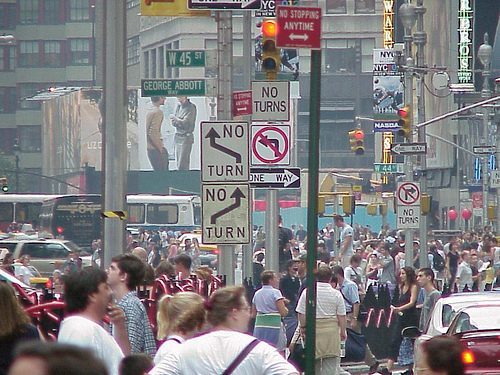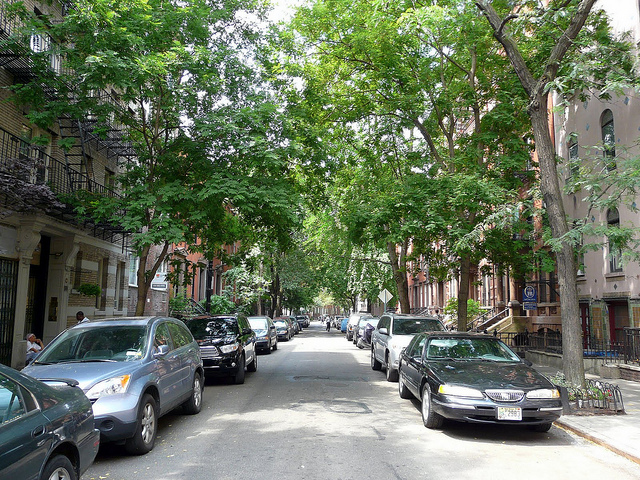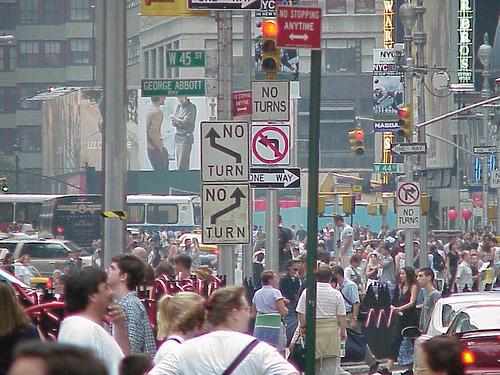 New York City may not be the best example of a place that hasn’t lived up to its potential for greater density.Photo: Randy von LiskiCross-posted from the Natural Resources Defense Council.
New York City may not be the best example of a place that hasn’t lived up to its potential for greater density.Photo: Randy von LiskiCross-posted from the Natural Resources Defense Council.
New York County, which comprises all of Manhattan, is the densest county in America at 71,166 people per square mile. It is twice as dense as No. 2, Brooklyn (which, incidentally, is followed by two more New York City counties, Bronx and Queens, at Nos. 3 and 4, respectively). Manhattan is over four times as dense as No. 5 San Francisco.
This makes me wonder about Ed Glaeser, a libertarian economist who is the latest hero of some of my New Urbanist friends, who have been promoting the heck out of his upcoming speech at their annual meeting. Glaeser thinks Manhattan could be so much better if, you know, we just got rid of some of those pesky rules that get in the way of building still more density. I’m not exaggerating, and I’ll give some examples in a minute.
 Ed Glaeser.But, first, I want to add some context, because Glaeser has some very important, and valid, points to make about the inherent efficiency of cities. They are essentially the same points made two years ago by David Owen in his book Green Metropolis (and his earlier essay, Green Manhattan): when people are clustered in cities, they take up less space; emit far less energy, particularly from driving; and generate more economic productivity, than they would if spread out. The first two of those are fundamental tenets of smart growth, actually, and my new urbanist friends are not wrong to be glad that Glaeser has joined the chorus. (I agree with the third point, too.) He also supports a carbon tax.
Ed Glaeser.But, first, I want to add some context, because Glaeser has some very important, and valid, points to make about the inherent efficiency of cities. They are essentially the same points made two years ago by David Owen in his book Green Metropolis (and his earlier essay, Green Manhattan): when people are clustered in cities, they take up less space; emit far less energy, particularly from driving; and generate more economic productivity, than they would if spread out. The first two of those are fundamental tenets of smart growth, actually, and my new urbanist friends are not wrong to be glad that Glaeser has joined the chorus. (I agree with the third point, too.) He also supports a carbon tax.
Glaeser’s current book is called The Triumph of the City. It has received a lot of attention and praise, not least because its author is an intellectual who does his homework and packs a lot of detail into his writing. He has also been in the media nonstop, or so it seems, for about a year or so (e.g., The New York Times; NPR; The Atlantic; Neil Peirce’s column for Citiwire; The Next American City; and, yes, Grist). Either Glaeser or his publicist is an awesome promoter, a skill I sometimes wish I had.
He previewed the book in The Atlantic, in an article called “How Skyscrapers Can Save the City.” Here’s Glaeser’s pro-density argument in a nutshell:
The magic of cities comes from their people, but those people must be well served by the bricks and mortar that surround them. Cities need roads and buildings that enable people to live well and to connect easily with one another … in the most desirable cities, whether they’re on the Hudson River or the Arabian Sea, height is the best way to keep prices affordable and living standards high.
It’s basically about efficient use of land, and I agree with much of it, though personally I think there is a lot of room for more density in most American cities and suburbs without making it all about skyscrapers. I also agree, to an extent, with other points Glaeser makes in that article and in the book about overzealous NIMBYs and over-prescriptive zoning.
But here’s the rub: a lot of what makes cities great is not just their efficiency, but the inefficiencies that also make them attractive and livable. Take historic preservation, which seems to really annoy Glaeser:
New York’s vast historic districts, which include thousands of utterly undistinguished structures, don’t accomplish that goal. Worse, they impede new construction, keeping real estate in New York City enormously expensive (despite a housing crash), especially in its most desirable, historically protected areas. It’s time to ask whether New York’s big historic districts make sense.
He doesn’t mention that those “vast historic districts” haven’t prevented Manhattan from becoming over four times as dense as San Francisco, which as noted is America’s densest city outside of the boroughs of New York.
 Glaeser seems particularly annoyed by historic districts like Greenwich Village.Photo: Benjamin Dumas
Glaeser seems particularly annoyed by historic districts like Greenwich Village.Photo: Benjamin Dumas
Nor have they prevented the building of some 20 new towers of 400 feet or more in height (roughly 35+ stories) currently under construction in New York City, with many more in the pipeline. (By comparison, Boston only has 27 buildings total of 400 or more feet in height.) Louis J. Coletti of the Building Trades Employers’ Association told The New York Times in 2008 that, immediately prior to the recession, construction generated more than $30 billion in economic activity in New York in one year. Not to say that there isn’t another spot or three where yet another should go, but that doesn’t sound like too much restriction to me.
(Glaeser is not entirely wrong, by the way, to suggest that some buildings preserved as “historic” don’t deserve to be. But that’s a different discussion.)
By now you won’t be surprised to learn that Glaeser doesn’t think much of environmental protection, either:
Homes in coastal California use much less energy than homes in most other places in the country. New building in California, as opposed to Texas, reduces America’s carbon emissions. Yet, instead of fighting to make it easier to build in California, environmentalists have played a significant role in stemming the growth of America’s greenest cities.
Really? Metro San Diego grew 10 percent in the last decade, about the same as the country as a whole; it added 281,000 people. San Jose grew 6 percent, adding over a hundred thousand people. Los Angeles didn’t grow much percentage-wise, but there is no evidence that environmentalism played the slightest role in that; L.A. still added 463,000 people, more than the entire population of the city of Kansas City, Mo..
Look, I know more than most that NIMBYs sometimes wave a faux-environmental flag to oppose development that would actually benefit the environment. I’ve predicated the last two decades of my career to being pro-growth and pro-density in the right places and in the right ways, so I know Glaeser has a point; but, as with so many of his points, he carries it too far.
The truth is that environmental regulation makes cities cleaner, healthier, and more attractive. Metro Portland, with some of the greenest laws anywhere, grew 50 percent faster than the country as a whole in the last decade, in no small part because it’s a great place to live. Metro Portland also illustrates another point about environmentalism: when we protect land outside cities and suburbs, the cities and suburbs become stronger.
Fortunately, some urbanists have begun to parse the nuances in Glaeser’s work. Seattle’s Liz Dunn, for example, notes that what makes the best cities is not tall buildings per se but a granular multiplicity of building styles that foster a diversity of form and function. She is ultimately pro-density, but incrementally:
It isn’t reflected in static measures of square footage or units or building heights, but rather in a slow but steady turning of the dial toward a higher intensity of users, connection and access, resource efficiency, character and identity, and choices. Jane [Jacobs] would no doubt remind us that the critical issue isn’t what density should look like, or how much is enough, but rather how we insert it more surgically and gracefully.
Amen to that. Mike Mehaffy adds that sometimes tower blocks don’t deliver on their claims because of their monolithic nature, and that mid-rise buildings also produce environmental benefits.
Philip Langdon of New Urban News, like myself, grew tired of Glaeser’s excesses:
I enjoyed my first couple of hours with this book, but the further I read, the more I was dismayed by contradictions that make Triumph of the City less a coherent urban vision than a collection of bombs and barbs tossed at historic preservationists, environmentalists, labor unions, government regulators, mass transit enthusiasts, and other seemingly benighted souls.
Langdon also correctly observes that it is suburbs, not inner cities, that are most in need of adding density.
His colleague at New Urban News, Rob Steuteville, also has a few words to say:
Tearing down historic edifices to make way for 50-story buildings will do nothing to change the biggest land use issues facing the New York region and other U.S. metropolises.
Agreed.
Before leaving the topic, I want to return to a point I made earlier, because it’s important: Glaeser is right in his central points about cities and density. They are good for both the environment and the economy, so part of me is glad that his views are getting attention. My issue is with the lack of nuance and the failure to give enough credit to the benefits of preservation and environmental protection, both of which enrich our well-being and that of cities.
Oh — and there’s one more point: Manhattan may not be dense enough for Glaeser, but apparently an affluent outer suburb of Boston is. Because that’s where he lives, on six and a half acres.



